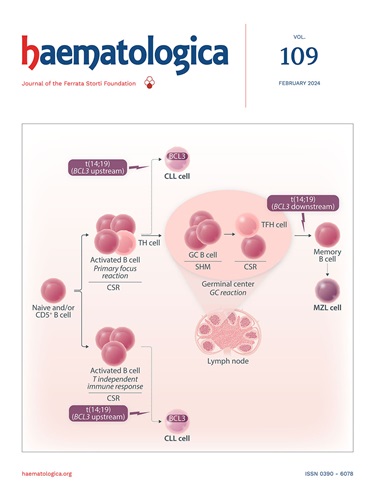Dental plaque microbiota following allogeneic hematopoietic cell transplantation and risk of chronic graft-versus-host disease.
IF 7.9
1区 医学
Q1 HEMATOLOGY
引用次数: 0
Abstract
Microbiota disruptions have been associated with short-term complications after allogeneic hematopoietic cell transplantation (alloHCT). However, only a few studies have examined the relationship between dysbiosis and chronic graft-versus-host disease (cGVHD), the main long-term immunologic toxicity of alloHCT. Considering the role of oral microbiota in systemic inflammatory diseases, we evaluated whether oral microbiota at day 28 post-HCT corresponding to clinical recovery from the acute events after transplantation is associated with subsequent cGVHD. Shotgun metagenomic sequencing of 207 saliva and supragingival plaque samples collected longitudinally at baseline (pre-conditioning), day +28, and day +84 from 37 patients (11 with subsequent moderate/severe cGVHD) revealed a significant association between day +28 plaque microbiota composition and cGVHD. Two orthogonal statistical approaches demonstrated Streptococcus sanguinis and Prevotella loescheii in day +28 plaque to be associated with cGVHD. Metagenome-based functional analysis identified 4 microbial metabolic pathways associated with future cGVHD, two of which were highly attributed to S. sanguinis. These pathways - ethanolamine utilization and glycerol metabolism - increase bacterial fitness by providing an alternative carbon/nitrogen source and improving survival in inflamed tissues. Our findings propose a novel mechanism by which the early post-transplant dental biofilm may contribute to cGVHD months later, offering a potential target for early prophylactic intervention.同种异体造血细胞移植后牙菌斑微生物群与慢性移植物抗宿主病的风险
微生物群破坏与同种异体造血细胞移植(alloHCT)后的短期并发症有关。然而,只有少数研究研究了生态失调与慢性移植物抗宿主病(cGVHD)之间的关系,cGVHD是同种异体造血干细胞移植的主要长期免疫毒性。考虑到口腔微生物群在系统性炎症疾病中的作用,我们评估了移植后急性事件临床恢复后hct后第28天的口腔微生物群是否与随后的cGVHD相关。在基线(预处理)、第28天和第84天纵向采集的37例患者(11例随后出现中/重度cGVHD)的207份唾液和龈上斑块样本的Shotgun宏基因组测序显示,第28天斑块微生物群组成与cGVHD之间存在显著关联。两种正交统计方法表明,+28天斑块中的血链球菌和罗氏普雷沃氏菌与cGVHD相关。基于宏基因组的功能分析确定了4条与未来cGVHD相关的微生物代谢途径,其中两条高度归因于血链球菌。这些途径-乙醇胺利用和甘油代谢-通过提供替代碳/氮源和提高炎症组织的存活率来增加细菌适应性。我们的研究结果提出了一种新的机制,通过这种机制,早期移植后牙齿生物膜可能在几个月后促进cGVHD,为早期预防干预提供了一个潜在的目标。
本文章由计算机程序翻译,如有差异,请以英文原文为准。
求助全文
约1分钟内获得全文
求助全文
来源期刊

Haematologica
医学-血液学
CiteScore
14.10
自引率
2.00%
发文量
349
审稿时长
3-6 weeks
期刊介绍:
Haematologica is a journal that publishes articles within the broad field of hematology. It reports on novel findings in basic, clinical, and translational research.
Scope:
The scope of the journal includes reporting novel research results that:
Have a significant impact on understanding normal hematology or the development of hematological diseases.
Are likely to bring important changes to the diagnosis or treatment of hematological diseases.
 求助内容:
求助内容: 应助结果提醒方式:
应助结果提醒方式:


